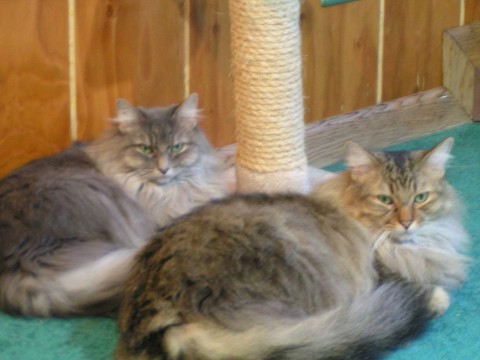Most of us have some idea of the frustration of dealing with our cats scratching up our furniture. While some respond to this by having their cats declawed, this is a bad solution. Amputating the first bone of each toe can result in lifelong problems for the cat. It’s important to understand that scratching is a normal, instinctive behavior. You should be encouraging healthy cat scratching behavior by giving your cat acceptable outlets for her need to scratch.
Encouraging healthy cat scratching behavior means not keeping your cat from scratching
The first thing in encouraging healthy cat scratching behavior is to avoid trying to train your cat not to scratch at all. Cats are happiest when they’re able to engage in all the behaviors that are normal to cats, like running, jumping, climbing, chasing, scratching and rubbing. When you discourage instinctive behaviors, you can confuse and stress out your cat, because she doesn’t understand why she can’t do those things that are natural for her. She’ll also just do them when you aren’t around.
Cat Behavior Associates says that scratching is far more than cats simply sharpening claws. While cats do scratch to sharpen their claws, they also do it to stretch and work their shoulder and back muscles.
Scratching is also a way for cats to mark territory. In the wild, the claw marks serve as warnings to other cats that someone has already claimed that territory. Besides that, cats have scent glands in their pads, and they can distribute scent by scratching.
Scratching can also relieve pent-up emotion. Cats that have excess energy for a variety of reasons may use scratching to relieve some of their feelings. That makes scratching a healthy outlet for emotion, and possibly one of the best reasons for encouraging healthy cat scratching behavior.
How do you go about encouraging healthy cat scratching behavior without sacrificing your furniture, though?
The first thing you can do to keep your cat from scratching your furniture is by making the furniture an unwelcome place. Use sticky tape, or spray it with something that smells pleasant to you, but is too strong for your cat. Maybe use sticky tape to stick aluminum foil, that’s also got sticky tape on it, on the places she likes to scratch.
If you do these things, instead of yelling at her or scaring her, you make the environment tell her not to scratch your furniture. This is far healthier and more effective for her than discipline ever will be.
Encouraging healthy cat scratching behavior requires more than deterrents, though
But that’s not enough. Encouraging healthy cat scratching behavior also means providing scratching surfaces for your cat, so she still has an outlet for her behavior. J. Ann Helgren of Petplace recommends having one scratching post per cat, plus one more, so that all your cats have their own “territory” to scratch.
Scratching posts should not be made entirely of carpet, according to Petplace, because carpet can’t withstand a cat’s claws very well. Plus, cats have been known to eat pieces of shredded carpet. A better post will have carpet on the perch(es), and sisal rope on the posts. Sisal rope is cheap, making the posts cheaper, and it’s far more durable than carpet. Plus, Helgren says that cats are more attracted to sisal rope than to carpet.
You can also use posts made of stripped tree trunks (or make your own). Because these are natural and durable, your cat will probably find these to be nice scratching surfaces also.
Long story short, if you pick the right surfaces and have an appropriate number of surfaces for your cat, you can encourage healthy cat scratching behavior without sacrificing your furniture to the cause. Your cat will be happier for it, and so will you.




